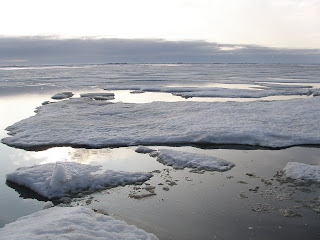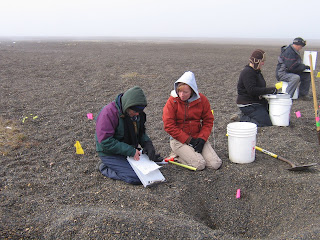




The flight up to Barrow was fascinating – and Hal said it was as clear as he has ever seen it in his 10-15 trips to and from Barrow. The pilot flew right next to Denali (Mt. McKinley) and circled it so we could see all sides of it – it felt like a cruise rather than a commercial plane flight! We could also see the dramatic changes in geography, from the abrupt rising of Denali and the other mountains in its range and the glaciers that filled many of the valleys (one of which is many miles long), to the heavily forested and green areas around Fairbanks, to the completely flat and water-pocked north slope on the north side of the Brooks mountain range. We had a short stop in Fairbanks, dropping of some people adding a few more, and then landed in Barrow around 7:15pm. There were some interesting characters on the flight to Barrow, and it made me wonder about the types of people who come here and live here. One very friendly couple was moving to Barrow, in part to be with their daughter and in part because they can earn higher salaries here than they could in the lower 48 states. They had bought boxes full of food and supplies at Costco and Wal-Mart and were brining them to last 3-4 months because the price of food and everyday goods is so much more expensive in Barrow. In Anchorage, much of the produce was close to twice the price as it is at home – I’m curious to see the prices in Barrow.
I have been through my first night of constant light, and it was weird but not too hard to sleep, probably because I didn’t go to bed until 11:30pm and I was tired out. I actually had my best night of sleep thus far. I took some photos before I went to bed (including a scenic view from my window ;)) but they weren’t very interesting because it just looked like early evening in terms of the light – I need to remember to label them or else I will have no idea why I took them.
Barrow is incredibly flat and barren, which also means it is very windy. It isn’t too cold (in the 40s yesterday and today, and without much variation in temps because the sun is always up), but the wind chill is noticeable. It is also very foggy, especially this morning, and you can’t see very far – it makes me see what Hal was saying about us being lucky with the views we had during yesterday’s flights. The town is pretty small, with a couple of large (five or six stories being the tallest) municipal buildings and corporate buildings, and then single family homes ranging from mobile homes to five or six-room, basic construction houses, and a couple of larger apartment complexes. There are three main sections to town – Barrow Center, (a big triangle which has the airport to the south of it, the ocean to the north and west and a lagoon to the east), Brower’s Center (a smaller triangle to the north and east of the lagoon), and NARL (the former Navy Arctic Research Lab, where BASC, a local college, and other US government agencies are located). There are no trees and everything is dirt (which supposedly becomes mud with rain and/or melting snow). The town is built close to the ocean, which still has some of the winter ice off the shore. Because of the wind, anything not held down tightly will blow through the air – this seems to be a major issue with trash, as papers and other garbage is lying all around.
We are here as part of BASC, though actually staying in a privately-run “hotel” in the NARL complex. This NARL area reminds me of an X-Files episode. The buildings are a mix of 1940s and 1950s Quonset huts and small buildings that are modified mobile homes, with a couple of larger buildings probably built in the 1970s and 1980s – very plain and simple rectangular designs, all one-story high. The buildings are surrounded by elevated pipes for water and gas (so they don’t freeze in the ground) and all sorts of old vehicles, machinery and leftover parts. From the outside, everything looks barren and discarded in an eerie way, but inside things are warm and comfortable in a homey way. The labs and living space reminds me or RMBL (where my sister Molly did her PhD research in Colorado) – basic facilities with a layer of dirt or mud on the exterior, and that have been personalized by the people who work and live here with there art work, posters, comic strip cutouts, etc. My room is like a small dorm room, with random pieces of furniture, most of them at least 10-20 years old. There is a satellite TV and a free washer/dryer unit, not to mention large bathroom and shower facilities, a water bubbler and other small comforts. We ate at a Japanese/Korean restaurant called Osaka last night – we mainly had sushi and other Asian foods, though they also had maple syrup on the shelf for breakfast pancakes and things like burgers, fries and BLTs on the menu – and met Steve, who has been doing science work up here for over 30 years and now is one of the logistics managers for scientists.












































